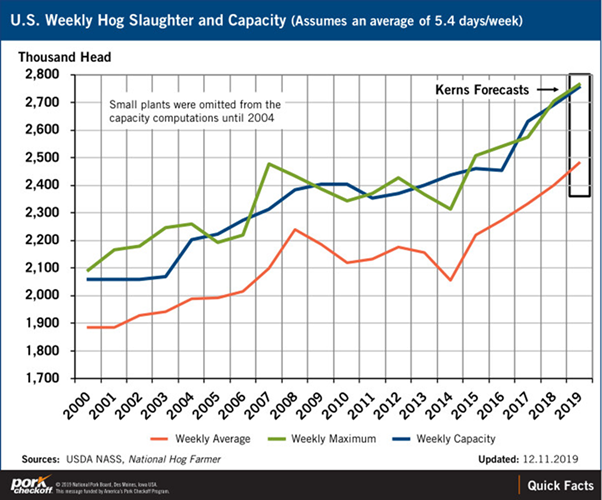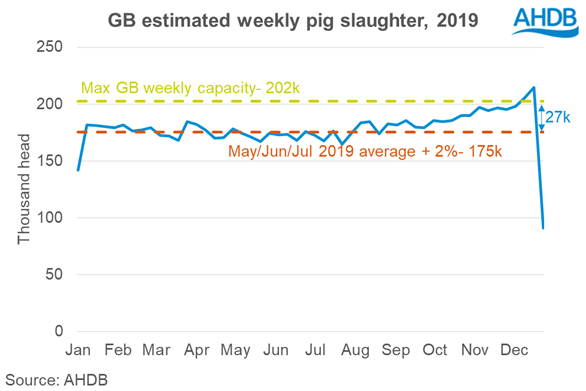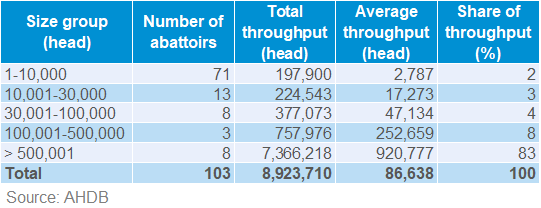Could we cope if key pig abattoirs close?
Thursday, 4 June 2020
By Bethan Wilkins
Background: Loss of US slaughter capacity
The US pig industry has hit the headlines recently. Significant outbreaks of COVID-19 amongst abattoir staff led a number of key pork processors to close, some for weeks at a time. At one point, the processing industry had reportedly lost about 40% of its capacity. With pigs unable to go to slaughter on time, some producers have been forced to euthanize pigs for which they have insufficient space to keep humanely and no market.
While almost all abattoirs are now said to be running to some extent, capacity is still reduced due to staff sickness and distancing measures. It will likely take several months for the supply chain to get back to normal operations.
The US industry is poorly equipped to cope with any reduction in slaughter capacity. Weekly slaughter is typically close to maximum capacity throughout the year, meaning it is difficult to make compensatory adjustments if something goes wrong.

What is the situation in Britain?
GB slaughter capacity
Unlike in the US, British abattoirs do not make their theoretical capacity publically available. However, we can make a reasonable estimate for GB maximum weekly throughput by looking at estimated slaughter in the weeks running up to Christmas. An average of the five top weeks’ kill in 2019 suggests maximum throughput is about 202,000 head per week, including sows. Although there are a few weeks when slaughter has been higher than this, such throughputs are likely to be difficult to achieve at short notice, and not sustainable over a number of weeks.
At this time of year however, slaughter is typically quite far from the maximum. From May-July 2019, GB weekly slaughter averaged 172,000 head. This year, we expect about 2% more pigs to be available, which would give us an average of 175,000 head. This means that during the early summer, we need kill across Britain to average 87% of capacity.
So, theoretically, there should be about 27,000 head of spare capacity available each week during the next couple of months. This gives some room for compensatory adjustments to be made if normal slaughter is disrupted at one or more plants.
Of course, if an abattoir closes, the spare capacity in the system will be lower than this, as the closed abattoir’s contribution will be lost. Logistical constraints around transport and staffing availability may also mean that this theoretical spare capacity cannot be achieved in reality.

How many abattoirs would need to close before we exceed the spare weekly capacity?
The vast majority of pigs in England are slaughtered in large abattoirs, with an annual throughput of over 500,000 head. Equivalent figures for Scotland are not available, but the picture is likely to be similar.
Size profile of all abattoirs slaughtering pigs in England, 2019

The eight largest abattoirs have an average annual throughput of 921,000 head, which equates to a weekly average of about 18,000 head. Estimated spare capacity at this time of year is about 27,000 head, although of course it will be a little lower than this if one or more abattoirs goes offline. Nonetheless, it seems likely that if one large abattoir closes, there should be enough spare capacity in the system elsewhere to compensate.
However, the closure of two large abattoirs is likely to present problems. This would displace about 36,000 head of pigs, which would be well above the spare capacity elsewhere. The significance of this problem would depend on how long the plants were offline or operating at reduced throughput.
Of course, these figures are averages, and in reality there will be a range of annual throughputs in the >500,000 head/year group. The average for this group is at 921,000 head, but there will be plants slaughtering more than this.
Within this group, it is certainly plausible that there is a single plant large enough to exceed the spare capacity elsewhere, if it were to close alone. A plant processing 1.4 million a year would slaughter about 27,000 head a week, and would likely exceed the spare capacity elsewhere, considering that there is only 27,000 head of spare capacity, when all the plants are operating.
Summary
It seems that while the pork supply chain has remained robust so far, there are vulnerabilities in the system. The concentration of pig slaughter means only a couple of large abattoirs would need to close for pigs to start backing up on farms. Current social-distancing and self-isolation guidelines also mean it may be more difficult to achieve the additional capacity potentially available than suggested here.
Sign up for regular updates
Subscribe to receive pork market news straight to your inbox. Simply complete our online form.
While AHDB seeks to ensure that the information contained on this webpage is accurate at the time of publication, no warranty is given in respect of the information and data provided. You are responsible for how you use the information. To the maximum extent permitted by law, AHDB accepts no liability for loss, damage or injury howsoever caused or suffered (including that caused by negligence) directly or indirectly in relation to the information or data provided in this publication.
All intellectual property rights in the information and data on this webpage belong to or are licensed by AHDB. You are authorised to use such information for your internal business purposes only and you must not provide this information to any other third parties, including further publication of the information, or for commercial gain in any way whatsoever without the prior written permission of AHDB for each third party disclosure, publication or commercial arrangement. For more information, please see our Terms of Use and Privacy Notice or contact the Director of Corporate Affairs at info@ahdb.org.uk © Agriculture and Horticulture Development Board. All rights reserved.

